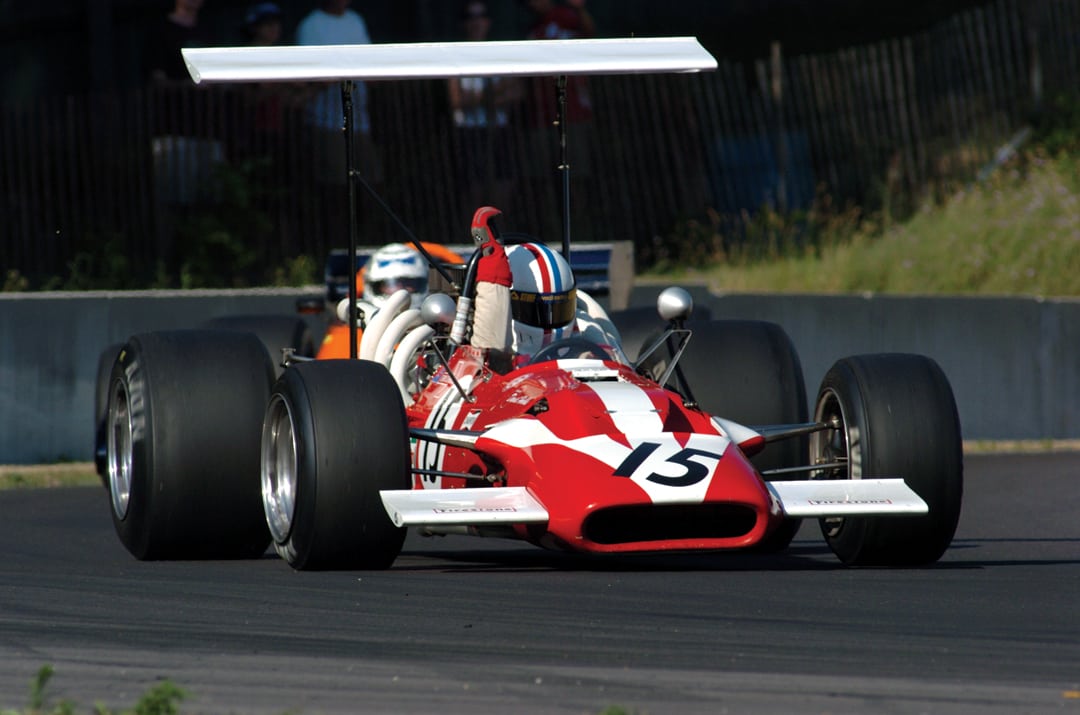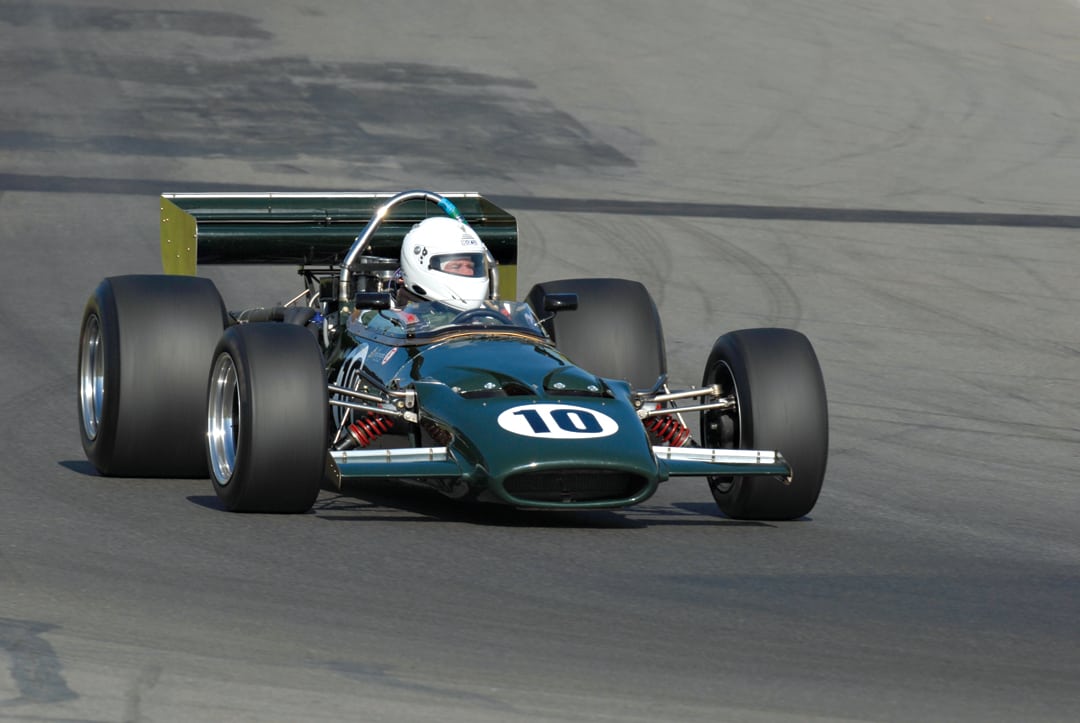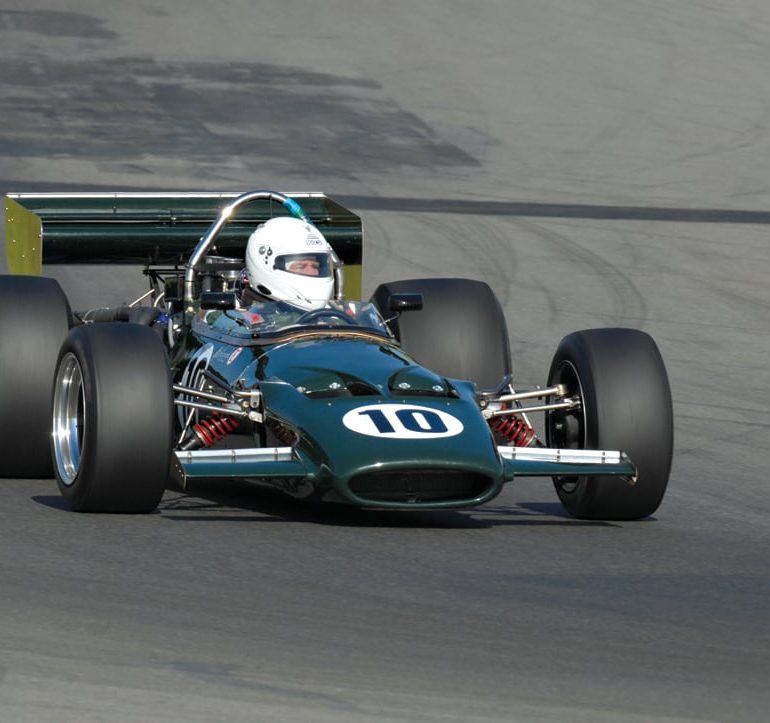Formula 5000 was a racing series for open-wheel, single-seater racing cars built to a specific set of rules. The engine of choice was the venerable small block Chevrolet V-8 of 5-liter displacement. It started as a bright idea in 1967 and ran successfully until politics between the governing body, race organizers, and team owners did it in, at the end of the 1976 season.
Although there were four competitive Formula 5000 championships: the Rothman’s series in Europe, the Tasman series in Australia and New Zealand, and the Tarmac series in Britain, the heart and soul of Formula 5000 was the North American series. In the early 1970s it was known as the L and M Championship after title sponsor L and M Tobacco. In 1974, the SCCA and rival governing body USAC merged to run Formula 5000. A variety of chassis manufacturers took part, but the car that dominated the later years of the series was the Lola T332. Even though the rules allowed the turbocharged Offenhauser engine to run, the engine that dominated the series was the Chevrolet 5-liter V-8 which could put out a reliable 550 bhp and 425 lbs-ft of torque at 8,000 rpm. In fact it would have been an all Chevrolet victory season if not for Jackie Oliver winning two races in a Dodge V-8-powered Shadow DN6.
Even though many top drivers such as Mario Andretti, Mark Donohue, David Hobbs, James Hunt, Alan Jones, Jackie Oliver, Jody Scheckter and Al Unser took part, the dominant driver one associates with Formula 5000 is Brian Redman, who won the championship in 1974, 1975, and 1976.
Today, Formula 5000 cars represent a lot of racing performance for one’s money. One of the most important factors in determining current market value is the cost and quality of the restoration. It is also important to note that currently, in New Zealand, Australia, and Great Britain, F5000 cars have a greater following than in America and, therefore, command a greater value. This combined with currency rates, import duties, and VAT can create a 25%–35% premium in the estimated value of the vehicle in these countries.
| Make | Model | Acceptance | Level III | Level II | Level I |
| Begg | FM2,FM4,FM5 | 3 | $75,000 | $90,000 | $100,000 |
| Caldwell | D8 | 3 | $55,000 | $70,000 | $80,000 |
| Chevron | B24 | 3 | $90,000 | $105,000 | $115,000 |
| B28 | 3 | $80,000 | $100,000 | $110,000 | |
| B37 | 3 | $80,000 | $100,000 | $110,000 | |
| Cooper | T90 | 3 | $60,000 | $80,000 | $100,000 |
| Crossle | 15F | 3 | $60,000 | $75,000 | $95,000 |
| Eagle | 1968 | 3 | $65,000 | $80,000 | $90,000 |
| 73A | 3 | $75,000 | $100,000 | $110,000 | |
| 755 | 3 | $95,000 | $110,000 | $125,000 | |
| Elfin | MR5, 6, 8, 9 | 3 | $65,000 | $100,000 | $115,000 |
| Leda | LT20, 22, 25 | 3 | $70,000 | $85,000 | $100,000 |
| LeGrand | Mk7 | 3 | $50,000 | $65,000 | $75,000 |
| Lola | T140-142 | 3 | $55,000 | $65,000 | $80,000 |
| T190 | 3 | $60,000 | $70,000 | $85,000 | |
| T191, 192 | 3 | $65,000 | $75,000 | $70,000 | |
| T300 | 3 | $75,000 | $85,000 | $100,000 | |
| T330, 332 | 3 | $85,000 | $105,000 | $120,000 | |
| T400 | 3 | $85,000 | $105,000 | $120,000 | |
| Lotus | 70 | 3 | $90,000 | $105,000 | $120,000 |
| March | 73A | 3 | $70,000 | $90,000 | $105,000 |
| 74A, 75A, 76A | 3 | $75,000 | $95,000 | $110,000 | |
| McKee | Mk8 | 3 | $70,000 | $85,000 | $100,000 |
| Mk12, 18 | 3 | $70,000 | $85,000 | $100,000 | |
| McLaren | M10A, B | 3 | $90,000 | $110,000 | $120,000 |
| M18 | 3 | $80,000 | $100,000 | $115,000 | |
| M22 | 3 | $80,000 | $100,000 | $115,000 |
| McRae | GM1 | 3 | $80,000 | $95,000 | $105,000 |
| Shadow | DN6 | 3 | $75,000 | $95,000 | $110,000 |
| Spectre | HR-1 | 3 | $60,000 | $70,000 | $85,000 |
| Surtees | TS5, TS8 | 3 | $70,000 | $80,000 | $100,000 |
| TS11 | 3 | $75,000 | $85,000 | $105,000 | |
| Talon | MR1 | 3 | $60,000 | $70,000 | $85,000 |
| Trojan | T101 | 3 | $60,000 | $75,000 | $85,000 |
| T102 | 3 | $65,000 | $80,000 | $90,000 |
Surtees TS5, TS8, TS11, F5000

John Surtees, who had been a motorcycle and Formula One World Champion, became a racecar constructor when he took over the Len Terry-designed LEDA F5000 project. A redesign of the project brought about the Surtees TS5 F5000 car in 1969. Even though Surtees built Formula One cars, the F5000 racecars brought team Surtees some of their greatest victories, and enabled them to sell cars to racing customers. The TS5 had a full monocoque chassis, conventional suspension and a 5-liter Chevrolet V-8 mated to a Hewland 5-speed gearbox. Noted drivers were David Hobbs, Andrea DeAdamich, and Trevor Taylor. Taylor finished 2nd in the 1969 Guards F5000 Championship. The 1971 TS8 was much improved and brought Surtees even greater success. It was driven by Mike Hailwood who won the first time out and finished 2nd in the Rothman’s Championship. The 1972 TS11, F5000 was based on the TS9 Formula One car and was driven by Gijs Van Lennep who won the European Championship.
McLaren M10A–B F5000

Bruce McLaren’s company had considerable success in Can-Am racing and had started venturing into Formula One with their M7A, when McLaren’s design team, which included Gordon Coppuck, decided to build the M10A F5000 car. The M7A was modified to accommodate the 5-liter Chevrolet V-8 and Hewland LG600 gearbox. The M10A was a more sophisticated monocoque design than its rival the Lola T140, which had a simple spaceframe. McLaren’s build and design standards were first class and this was reflected in the much higher price charged. An M10A was entered for Peter Gethin in the British series. Gethin won the championship over Trevor Taylor’s Surtees TS5 but only at the last race of the year.
In the United States, Sam Posey ran an M10A with considerable success only losing out to the Eagle of Tony Adamowicz. In 1970, the much-modified M10B was introduced with various improvements and the lighter Hewland DG300 gearbox. McLaren’s success continued in Europe with Peter Gethin winning eight races. Other notable drivers were Graham McRae, Howden Ganley, and Reine Wissel. Seventeen M10A’s and 21 M10B’s were built by Trojan, McLaren’s division for customer cars. Today, these cars are a shining example of McLaren’s technical achievements and a joy to see run.
Criteria Used For Assessing Valuations for this Guide:
- Degree of Originality
- Overall Condition, Restoration
- Technology, Design, Coachbuilder
- Production Numbers/Rarity
- Competition History
- Ownership History, Documentation
- Modern Event Eligibility
Regional Variances
The prices stated in this guide are based on U.S. values. The values of historic racing cars can vary as much as 25%-35% in other countries, depending on local market appeal, currency rates, import duties, and VAT. Most of the time, we are able to document known sales or closed escrows, as they say in real estate. When this is not possible, a logical estimate of the car’s value is given, based on its sales history and relationship to cars of its type.
The prices stated in this guide are based on U.S. values. The values of historic racing cars can vary as much as 25%-35% in other countries, depending on local market appeal, currency rates, import duties, and VAT.
LEVEL |
VALUATION CATEGORIES |
|---|---|
I |
The best combination of all criteria. |
II |
Satisfies mid-range of criteria. |
III |
In need of restoration. Meets only a few points of criteria |




